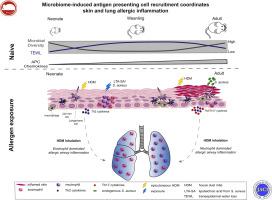Journal of Allergy and Clinical Immunology ( IF 11.4 ) Pub Date : 2020-07-15 , DOI: 10.1016/j.jaci.2020.06.030 Niki D Ubags 1 , Aurélien Trompette 1 , Julie Pernot 1 , Britt Nibbering 1 , Nicholas C Wong 2 , Céline Pattaroni 3 , Alexis Rapin 1 , Laurent P Nicod 1 , Nicola L Harris 3 , Benjamin J Marsland 4

|
Background
Allergic skin inflammation often presents in early childhood; however, little is known about the events leading to its initiation and whether it is transient or long-term in nature.
Objective
We sought to determine the immunologic rules that govern skin inflammation in early life.
Methods
Neonatal and adult mice were epicutaneously sensitized with allergen followed by airway allergen challenge. Epicutaneous application of labeled allergen allowed for determination of antigen uptake and processing by antigen-presenting cells. RNAseq and microbiome analysis was performed on skin from neonatal and adult specific pathogen-free and germ-free mice.
Results
A mixed TH2/TH17 inflammatory response in the skin and the lungs of adult mice was observed following sensitization and challenge. Comparatively, neonatal mice did not develop overt skin inflammation, but exhibited systemic release of IL-17a and a TH2-dominated lung response. Mechanical skin barrier disruption was not sufficient to drive allergic skin inflammation, although it did promote systemic immune priming. Skin of neonatal mice and adult germ-free mice was seeded with low numbers of antigen-presenting cells and impaired chemokine and alarmin production. Enhanced chemokine and alarmin production, and seeding of the skin with antigen-presenting cells capable of instructing recruited cells to elicit their effector function, was, at least in part, dependent on formation of the microbiome, and consequently contributed to the development of overt skin disease.
Conclusions
These data shed light on the principles that underlie allergic inflammation in different tissues and highlight a window of opportunity that might exist for early-life prevention of allergic diseases.
中文翻译:

微生物组诱导的抗原呈递细胞募集协调皮肤和肺部过敏性炎症
背景
过敏性皮肤炎症通常出现在儿童早期;然而,对于导致其发生的事件以及它是短暂的还是长期的,我们知之甚少。
客观的
我们试图确定控制生命早期皮肤炎症的免疫规则。
方法
用过敏原对新生和成年小鼠进行表皮致敏,然后进行气道过敏原攻击。标记过敏原的表皮应用允许确定抗原呈递细胞对抗原的摄取和加工。RNAseq 和微生物组分析对来自新生和成年无特定病原体和无菌小鼠的皮肤进行。
结果
在致敏和激发后,在成年小鼠的皮肤和肺中观察到混合的 T H 2/T H 17 炎症反应。相比之下,新生小鼠没有出现明显的皮肤炎症,但表现出 IL-17a 和 T H 的全身释放2-主导的肺反应。机械性皮肤屏障破坏不足以引起过敏性皮肤炎症,尽管它确实促进了全身免疫启动。新生小鼠和成年无菌小鼠的皮肤接种了少量的抗原呈递细胞,并且趋化因子和警报素的产生受损。增强趋化因子和警报素的产生,以及将抗原呈递细胞植入皮肤,能够指导募集的细胞引发其效应功能,至少部分依赖于微生物组的形成,并因此促进了皮肤的发育疾病。
结论
这些数据阐明了不同组织中过敏性炎症的基础原理,并突出了可能存在的早期预防过敏性疾病的机会之窗。











































 京公网安备 11010802027423号
京公网安备 11010802027423号